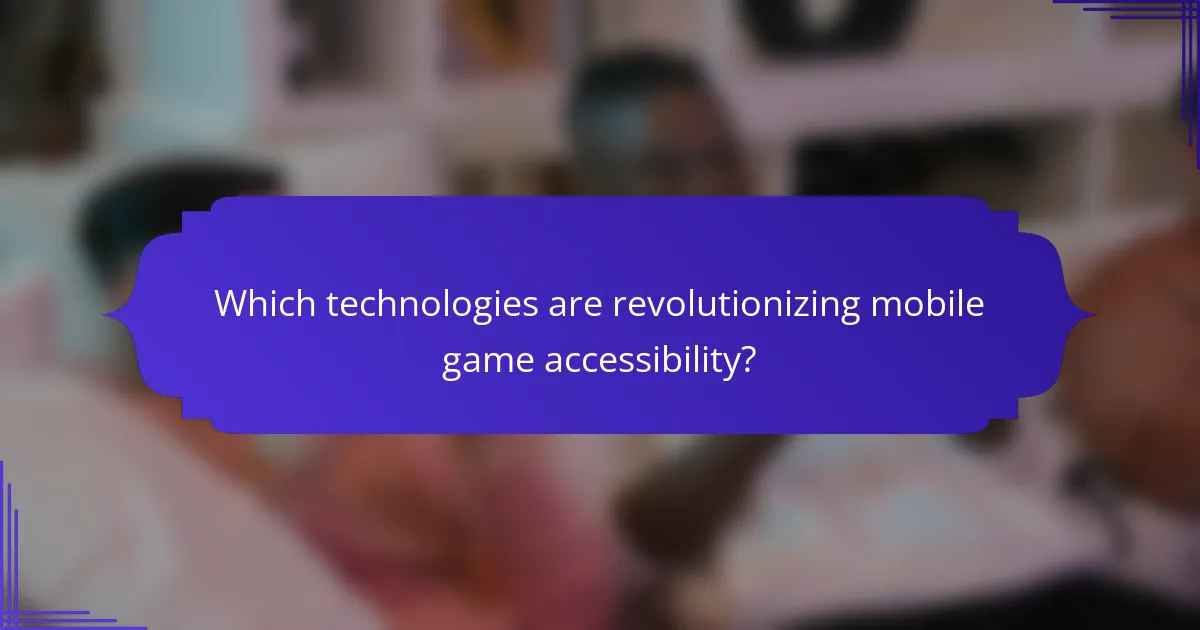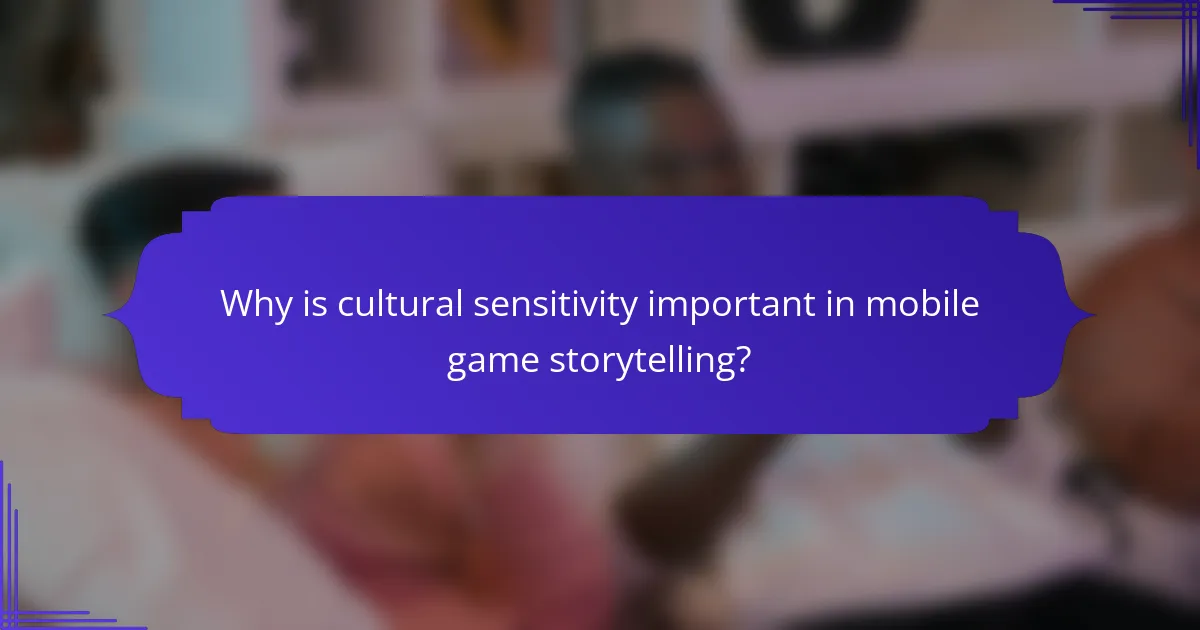Mobile game accessibility enhances user engagement by allowing players with diverse abilities to fully participate. This article explores the challenges developers face in creating accessible games, the technologies revolutionizing accessibility, the importance of cultural sensitivity in storytelling, and the metrics for evaluating accessibility. Future trends show a commitment to inclusive features that ensure enriching experiences for all players.

How does mobile game accessibility enhance user engagement?
Mobile game accessibility significantly enhances user engagement by allowing players with diverse abilities to participate fully. Features like customizable controls, visual aids, and audio descriptions cater to various needs, fostering inclusivity. As a result, games reach broader audiences, increasing player retention and satisfaction. Enhanced accessibility creates immersive experiences that resonate with users, promoting community and interaction.
What are the primary features of accessible mobile games?
Accessible mobile games feature user-friendly interfaces, customizable controls, and adaptive difficulty levels. These attributes enhance engagement for players with diverse needs. Accessibility options may include voice commands, text-to-speech, and colorblind modes. Such features ensure that interactive storytelling reaches a broader audience, fostering inclusivity in gaming experiences.
Which design principles support inclusive gameplay experiences?
Inclusive gameplay experiences are supported by principles such as universal design, flexible controls, and clear communication. These principles ensure that diverse audiences can engage with mobile games effectively.
Universal design emphasizes creating games accessible to all players, regardless of ability. Flexible controls allow customization for different preferences and needs, enhancing user experience. Clear communication involves using straightforward language and visual cues, making gameplay intuitive for everyone.
Additionally, feedback mechanisms are vital. They enable players to understand their progress and make necessary adjustments. Regular testing with diverse user groups helps identify barriers and improve accessibility features, ensuring a more inclusive environment.

What challenges do developers face in creating accessible mobile games?
Developers face significant challenges in creating accessible mobile games, including limited resources, diverse user needs, and technical constraints. Ensuring compatibility with assistive technologies is often complex. Developers must also navigate varying accessibility standards across platforms. Furthermore, the lack of user feedback from individuals with disabilities can hinder effective design choices. Balancing accessibility with engaging gameplay remains a persistent challenge.
How can developers address technical limitations for diverse audiences?
Developers can address technical limitations by implementing adaptive technologies and inclusive design practices. They should prioritize user feedback from diverse audiences to identify specific needs.
Utilizing features like customizable controls, color contrast adjustments, and text-to-speech can enhance accessibility. Regular testing with users from various backgrounds ensures that games cater to all abilities.
Collaborating with accessibility experts can provide insights into best practices. This approach not only improves user experience but also expands the game’s reach, fostering a more inclusive gaming community.
Investing in training for developers on accessibility standards promotes ongoing awareness and innovation in mobile game design.
What are common misconceptions about accessibility in mobile gaming?
Many believe mobile gaming is inherently accessible, but this is misleading. Accessibility varies significantly across games, often overlooking diverse user needs. One common misconception is that all mobile games automatically adapt to assistive technologies. In reality, developers must intentionally design features like screen readers or customizable controls. Another myth is that accessibility only benefits users with disabilities; it enhances the experience for all players by providing options. Additionally, some think accessibility is a one-time effort, while it requires ongoing updates and user feedback to remain effective. Lastly, many assume that adding accessibility features detracts from gameplay, yet it can enrich interactive storytelling by making narratives more inclusive.

Which technologies are revolutionizing mobile game accessibility?
Technologies revolutionizing mobile game accessibility include adaptive controllers, voice recognition software, and augmented reality. These innovations enhance gameplay for diverse audiences, ensuring inclusivity. Adaptive controllers allow customization for various physical abilities. Voice recognition software enables hands-free gameplay for users with mobility challenges. Augmented reality creates immersive experiences that can be tailored to individual needs, broadening engagement.
How do adaptive technologies improve gameplay for players with disabilities?
Adaptive technologies enhance gameplay for players with disabilities by providing tailored solutions that address specific needs. These technologies include screen readers, customizable controls, and haptic feedback systems, which create an inclusive gaming experience. For example, voice recognition allows players with mobility impairments to interact effectively. As a result, adaptive technologies not only improve accessibility but also enrich interactive storytelling for diverse audiences.
What role do user interface (UI) and user experience (UX) design play in accessibility?
User interface (UI) and user experience (UX) design are crucial for enhancing accessibility in mobile games. Effective UI/UX design ensures that diverse audiences can engage with interactive storytelling seamlessly.
UI elements must be visually clear and easy to navigate, accommodating various abilities. For example, high-contrast colors and scalable text sizes improve readability for users with visual impairments.
UX design focuses on creating intuitive experiences, which include comprehensive tutorials and adaptive controls. These features enable users with different skill levels to enjoy the game fully.
Incorporating accessibility features into UI and UX design not only broadens audience reach but also fosters inclusivity in interactive storytelling.

Why is cultural sensitivity important in mobile game storytelling?
Cultural sensitivity is crucial in mobile game storytelling as it fosters inclusivity and engagement among diverse audiences. By respecting cultural nuances, developers create relatable narratives that resonate with players from various backgrounds. This approach enhances player experience and broadens market reach, leading to higher engagement and retention rates. Additionally, culturally sensitive storytelling can prevent misrepresentation and promote positive social messages, contributing to a more respectful gaming environment. Ultimately, prioritizing cultural sensitivity enriches interactive storytelling and supports the growth of a diverse gaming community.
How can developers incorporate diverse narratives in gameplay?
Developers can incorporate diverse narratives in gameplay by integrating characters, settings, and storylines that reflect various cultures and experiences. This approach enhances player engagement and broadens the game’s appeal.
1. Collaborate with diverse writers to ensure authentic representation.
2. Include customizable character options to reflect different backgrounds.
3. Design branching storylines that allow players to experience multiple perspectives.
4. Utilize community feedback to refine narratives and ensure inclusivity.
Which case studies exemplify successful culturally inclusive mobile games?
Several case studies highlight successful culturally inclusive mobile games. “The Walking Dead: Our World” integrates diverse narratives, allowing players from various backgrounds to engage with the story. “Baba Is You” incorporates unique gameplay mechanics that resonate with different cultural perspectives, fostering inclusive play. “Sonic Dash” features characters from various cultures, enhancing relatability and engagement. “Monument Valley” offers visually stunning environments inspired by global architecture, promoting cultural appreciation. “FIFA Mobile” celebrates global sports culture, providing localized experiences that connect players worldwide. These examples demonstrate how culturally inclusive elements can enhance mobile game accessibility and storytelling.

What metrics should be used to evaluate accessibility in mobile games?
To evaluate accessibility in mobile games, focus on metrics such as usability, player engagement, and adaptive features. These metrics ensure games reach diverse audiences effectively.
| Metric | Description | Importance |
|—————————|————————————————–|———————————————-|
| Usability | Ease of navigation and interaction | Enhances player experience |
| Player Engagement | Time spent and frequency of play | Indicates enjoyment and retention |
| Adaptive Features | Customization options for different needs | Supports a wider range of players |
| Feedback Mechanisms | User feedback channels and response times | Allows continuous improvement |
| Compliance Standards | Adherence to accessibility guidelines | Ensures legal and ethical responsibilities |
| Performance Metrics | Load times and responsiveness | Affects overall user satisfaction |
How can player feedback inform accessibility improvements?
Player feedback is essential for enhancing mobile game accessibility. It provides insights into user experiences, identifying barriers that diverse audiences face. Analyzing feedback helps developers prioritize features that improve usability, such as customizable controls and visual options. Engaging with players fosters a community that values inclusivity, ensuring that storytelling resonates across various demographics. As a result, games can reach a broader audience, enriching the interactive experience for all players.
What are the best practices for measuring success in inclusive design?
To measure success in inclusive design for mobile game accessibility, focus on user feedback, engagement metrics, and accessibility compliance. Collect qualitative insights from diverse players to assess their experiences and satisfaction. Analyze quantitative data such as retention rates and session lengths to gauge engagement across varied demographics. Ensure adherence to accessibility standards like WCAG to validate inclusivity.

What future trends are shaping mobile game accessibility?
Future trends are enhancing mobile game accessibility through innovative design and technology. Developers increasingly prioritize inclusive features, such as customizable controls, voice commands, and adaptive difficulty levels. These advancements ensure that diverse audiences, including those with disabilities, can engage with interactive storytelling. Additionally, the integration of assistive technologies, like screen readers and haptic feedback, is becoming standard practice. As a result, mobile games are evolving to be more inclusive, offering enriching experiences for all players.
How will AI influence the development of accessible gaming experiences?
AI will significantly enhance the development of accessible gaming experiences by personalizing interactions and optimizing gameplay for diverse audiences. AI technologies can analyze user preferences and abilities, adapting game mechanics accordingly. For example, AI-driven tools can create tailored difficulty levels, ensuring players of all skill sets remain engaged. Additionally, AI can facilitate voice recognition and text-to-speech features, improving accessibility for players with disabilities. As a result, the gaming industry can reach a broader audience, fostering inclusivity and enhancing interactive storytelling across mobile platforms.
What emerging platforms are enhancing accessibility in mobile gaming?
Emerging platforms enhancing accessibility in mobile gaming include cloud gaming services, augmented reality (AR) applications, and adaptive controllers. These innovations allow diverse audiences to engage with interactive storytelling more effectively. For instance, cloud gaming enables access to high-quality games on lower-end devices, while AR applications create inclusive experiences by integrating real-world environments. Adaptive controllers cater to various physical abilities, ensuring that everyone can participate in mobile gaming.
What are expert tips for optimizing accessibility in mobile game design?
To optimize accessibility in mobile game design, developers should focus on inclusive features. Prioritize customizable controls, enabling users to adjust settings for comfort. Implement audio descriptions and visual aids to assist players with disabilities. Ensure compatibility with screen readers and provide clear navigation cues. Regularly test games with diverse user groups to gather feedback and make improvements.
